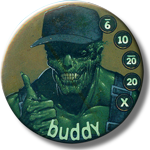There are only three possible attacks, so this isn't too hard to figure out by brute force -- but can you see it quickly?
ElihuRoot performed Power attack using [(X=4):4] against [(12):3]; Defender (12) was captured; Attacker (X=4) rerolled 4 => 1.
Game #3311 • ElihuRoot (Buddy) vs. sansibaman (Kith) • Round #5
Opponent's turn to attack

s(6) (10) s(20) (20) (X)
Button: Buddy
Player: ElihuRoot
|
Player: sansibaman
Button: Kith
(6) (8) (12) (12) (X)
 |
2 comments:
No - I definitely don't see it quickly. :(
I think sansibaman can win by capturing the d6 and the d4, and not giving up either of their dice.
The 3 possible moves are
[(12):12]-->[(6):4] leaving d6 captured by d4 immediately
[(12):12]-->[(4):1] leaving d12 vulnerable to d6 on a 4, 5, or 6?
[(6):1]-->[(4):1] leaving d6 vulnerable to d6 on a 4, 5 or 6?
I think the middle option has the best chance of success. 75% versus 50%.
This game is difficult (fun), and I still don't get it. :)
That's close, but the middle case is not *quite* that good: if the d12 rolls 4,5,6 it's captures, but if it rolls 1 or 2, you have to pass without capturing the s6 and still wind up behind on points. you win with if it rerolls 7-12 or with a 3, so it wins with probability 7/12 (58.3)% -- still the best move.
This really just restates the computation, but somehow feels easier to me: You know you must capture both dice without losing any more of your own -- that forces you to capture the X4 on your first attack, and then the question is which way of taking it gives more chances of avoiding recapture *and* capturing the s6.
Post a Comment